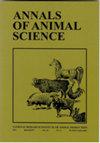阿拉比卡咖啡L对高温饲养育肥兔生长性能、健康状况和经济效益影响的量效分析
IF 1.9
4区 农林科学
Q1 Veterinary
引用次数: 0
摘要
摘要采用量效分析方法,研究了绿咖啡(GC)对新断奶家兔生长性能、饲料利用、胴体性状和健康状况的影响。选择夏季饲养的5周龄临床健康生长兔60只,随机分为3个试验组,每组20只,分别饲喂0、2、4 g GC /kg饲粮(GC0、GC2、GC4)。与对照组相比,gc处理组的生长性能(活体重、LBW、平均日增重、ADG)、饲料利用率(饲料系数、FCR)、屠宰率和肝脏相对重量均显著提高。剂量-效应回归分析结果表明,平均日增重和脂肪比的最佳添加量分别为2.75和3g GC/kg。此外,与GC0相比,GC处理显著降低了直肠温度和呼吸速率,最佳剂量为2.5g GC /kg日粮。与GC0组相比,gc治疗组红细胞和白细胞计数明显改善。添加GC后血蛋白及其组分、肝肾功能和血脂呈二次改善。总蛋白及其组分、ALT和TG的最佳剂量为3g GC/kg,肌酐和TC的最佳剂量分别为2.5和2.75 g GC/kg。gc处理组总抗氧化能力、超氧化物歧化酶和谷胱甘肽活性显著高于GC0处理组,丙二醛水平显著低于GC0处理组。与对照组相比,GC处理组血清免疫球蛋白A和g水平提高的最佳剂量为2.5g /kg。在经济上,饲粮中添加GC提高了饲粮的经济效益,从而提高了育肥过程的盈利能力。由此可见,饲粮中添加2.5 ~ 3g/kg水平的GC可有效提高夏季育肥家兔的生长指标、氧化还原状态、免疫功能和经济效益。本文章由计算机程序翻译,如有差异,请以英文原文为准。
Dose-response analysis for the effects of Coffea arabica L on growth performance, health status, and economic efficiency of fattened rabbits raised under high ambient temperature
Abstract The dose-response analysis was used to investigate the effects of green coffee (GC) on growth performance, feed utilization, carcass traits, and health status of newly weaned rabbits. A total of 60 clinically healthy growing rabbits (5-weeks old) reared during summer season were divided randomly into three experimental groups, 20 rabbits each, and received 0, 2, and 4 g GC /kg diet, (GC0, GC2, and GC4), respectively. Growth performance (live body weight, LBW and average daily gain, ADG) and feed utilization (feed conversion ratio, FCR) as well as the dressing percentage and the relative weight of liver were improved significantly in the GC-treated groups compared to the control group. The dose-response regression analysis showed that the optimal doses were 2.75 and 3g GC/kg diet for ADG and FCR, respectively. Moreover, GC treatments significantly decreased both of rectum temperature and respiration rate compared to GC0, with an optimal dose being at 2.5g GC /kg diet. Erythrocytes and leukocyte counts improved significantly in the GC-treated groups compared to the GC0 group. Blood protein and its fractions, liver and kidney functions, and lipid profile were quadratically improved by GC supplementation. The optimal dose was 3g GC/kg diet for total protein and its fractions, ALT, and TG, while it was 2.5 and 2.75 g GC/kg diets for creatinine and TC, respectively. Total antioxidant capacity, superoxide dismutase, and glutathione activities were significantly higher, while the levels of malondialdehyde were significantly lower in the GC-treated groups than the GC0 group. A level of 2.5g GC/kg diet was the optimal dose required for improving immunoglobulin A and G. improved in blood serum of GC treated groups compared to the control. Economically, dietary addition of GC enhanced the economic efficiency of the supplemented diets, thereby improving the profitability of the fattening process. In conclusion, dietary supplementation of GC at level of 2.5-3g/kg diet could be effectively used to enhance the growth indices, redox status, immune function, and economic efficiency of rabbits fattened during the summer season.
求助全文
通过发布文献求助,成功后即可免费获取论文全文。
去求助
来源期刊

Annals of Animal Science
AGRICULTURE, DAIRY & ANIMAL SCIENCE-
CiteScore
3.80
自引率
5.30%
发文量
138
期刊介绍:
Annals of Animal Science accepts original papers and reviews from the different topics of animal science: genetic and farm animal breeding, the biology, physiology and reproduction of animals, animal nutrition and feedstuffs, environment, hygiene and animal production technology, quality of animal origin products, economics and the organization of animal production.
 求助内容:
求助内容: 应助结果提醒方式:
应助结果提醒方式:


